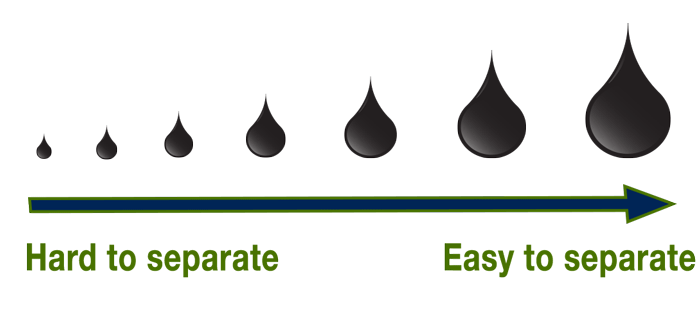Here’s an experiment you can try at home. If you take a jar of water and carefully pour in some oil it will very quickly form a layer on the surface. Now if you close the jar and shake it up as hard as you can you’ll end up with an oily mixture that won’t separate for a long time. This experiment shows one of the key concepts in oily water science – even if you have the same amounts of oil and water, two different samples can vary wildly in how easily they can be separated. So what causes this difference? Droplet size!
1. Droplet Size – They Key Factor in Oil Separation
What happened when you shook the oil and water together? Originally there was a large layer of oil floating on the surface, but after you shook it there were tiny droplets of oil spread throughout the water. What changed was the size of the droplets, and this makes a huge difference – larger droplets of oil are far easier to remove than smaller ones. The physics behind this is complex, but essentially larger droplets float upwards faster. In settling tanks, in plate packs and even in hydrocyclones, large droplets zip up to the surface like Ferraris while the smaller droplets take a leisurely stroll.

2. How to get the biggest droplets in town
So if big oil droplets can make separation nice and easy, how do we achieve that? The best way is to cut down on chemical use. Detergents, surfactants and other cleaning chemicals are great at cutting through dirt and grease to make things clean, but they also bind to the surface of oil droplets and tear them apart. Cutting down on these droplet-shrinking chemicals will keep your droplets large and make the oily water far easier to treat.
3. Picking the right system to suit your droplets
Different oily water separation technologies have different cut-off points for the smallest droplets they can treat. For instance, hydrocyclones can handle droplets down to 10 microns in size while most plate packs are unable to remove droplets below 60 microns in size. These smaller oil droplets won’t be separated out at all, and would be discharged with your ‘treated’ water. This can make it more difficult to stay within your license requirements or recycle your water. To prevent this from affecting your environmental compliance, ask all oily water vendors for a performance curve before you buy. A performance curve will tell you exactly how well a system removes different sizes of oil droplets. This takes away your risk when purchasing new equipment, and ensures that you’ll continue to meet your environmental requirements into the future.
